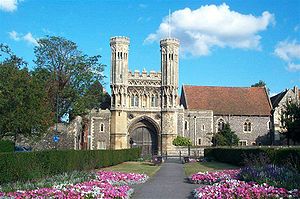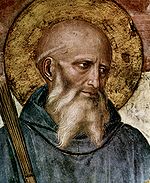- St Augustine's Abbey
-
For other uses, see St Augustine's Abbey (disambiguation).
Canterbury Cathedral, St. Augustine's Abbey, and St. Martin's Church * UNESCO World Heritage Site
Country United Kingdom Type Cultural Criteria i, ii, vi Reference 496 Region ** Europe and North America Inscription history Inscription 1988 (12th Session) * Name as inscribed on World Heritage List
** Region as classified by UNESCOSt Augustine's Abbey was a Benedictine abbey in Canterbury, Kent, England.[1]
Contents
Early history
In 597 Saint Augustine arrived in England, having been sent by Pope Gregory I, on what might nowadays be called a revival mission. The King of Kent at this time was Æthelberht, who happened to be married to a Christian, Bertha. Whether or not his spouse influenced him, he allowed Augustine to found a monastery just outside the walls of Canterbury to the east of the city. King Æthelberht ordered the church to be erected of "becoming splendour, dedicated to the blessed apostles Peter and Paul, and endowed it with a variety of gifts"[2] William Thorne, the late fourteenth-century chronicler of the Abbey, records 598 as the year of the foundation.[2] Already standing on the site were three Saxon churches, dedicated respectively to Saints Pancras, Peter and Paul, and finally Mary. The Saxon-phase remains of the church of Saint Pancras are still extant, however, the other two churches were rebuilt by the Normans into one building. One of the main purposes of the abbey right from the outset was as a burial place for the Kings of Kent and the Archbishops of Canterbury.
In 978 a new larger building was dedicated by Archbishop Dunstan, to the Saints Peter, Paul, and Augustine. An account by Goscelin of a miracle in the mid-11th century at the abbey for the benefit of the colourful monastic goldsmith Spearhafoc gives interesting details as to the contents of the church at this time.
12th century
By 1100 all remains of the original Anglo Saxon building had disappeared under a massive romanesque edifice, to which an Almonry was added in 1154. Apart from some rebuilding work in 1168 as a result of a fire, the rest of the 12th century passed fairly quietly at the abbey.
13th century
From about 1250 onwards the abbey was once again alive with building work. The cloister, lavatorium, frater and kitchen were totally rebuilt and a grand new abbot's lodging was built. The range was also extended to provide a great hall.
14th century
A new crenellated Great Gate was built in 1309 completing the Inner Court. On the north side the monks were able to take in much more land, which provided space for a new outer court with cellarer's range, brewhouse, bakehouse, and in 1320 a new walled vineyard. There was also expansion on the east side of the abbey where a series of lodgings were built along with a walled cellarer's garden. An earthquake in 1382 meant more building work, and in 1390 the gatehouse that still survives was built. The last thing to be built was a Lady Chapel, to the east of the church.
By 1500 the abbey covered a very large area, and its library contained in excess of 2000 volumes, a staggering number for the time. Many of these would have been produced in the abbey's own scriptorium.
Dissolution
In 1535 Henry VIII dissolved all monasteries found to have an annual income less than £100. It survived this first round of closures as its income was found to be £1733, but on 30 July 1538 the abbey's fate was sealed when it fell to the dissolution of Henry VIII. The abbey was systematically dismantled over the next fifteen years, although part of the site was converted to a palace, ready for the arrival of Anne of Cleves from Germany.
Notable burials
- Eadbald of Kent, King of Kent, at the Abbey of St Peter and St Paul
- Emma of Austrasia, Consort of Eadbald, also at the Abbey of St Peter and St Paul
- Justus, first Bishop of Rochester, fourth Archbishop of Canterbury and Saint
Modern history
This palace was leased to a succession of nobles, and in the early 17th century was in the possession of Edward Lord Wotton, who employed John Tradescant the elder, to lay out formal gardens around it. This palace is thought to have survived until a great storm in 1703, which certainly caused great damage to the already ruinous structure of the abbey.
Now a World Heritage Site, the ruins of this important monastic foundation built by Saint Augustine are in the care of English Heritage.
Today the ruin precincts cover a substantial area east of the cathedral, and in fact, in its heyday the abbey's church rivalled nearby Canterbury Cathedral in size.
The foundations of the main abbey building are located at 51°16′41.26″N 1°5′17.54″E / 51.2781278°N 1.0882056°ECoordinates: 51°16′41.26″N 1°5′17.54″E / 51.2781278°N 1.0882056°E
References
- ^
 "Abbey of Saint Augustine". Catholic Encyclopedia. New York: Robert Appleton Company. 1913.
"Abbey of Saint Augustine". Catholic Encyclopedia. New York: Robert Appleton Company. 1913. - ^ a b "Houses of Benedictine monks: The abbey of St Augustine, Canterbury", A History of the County of Kent: Volume 2 (1926), pp. 126-133. British History Online. Retrieved 30 July 2010.
External links
- St Augustine's Abbey - official site at English Heritage.
World Heritage Sites in the United Kingdom England Bath · Blenheim Palace · Canterbury Cathedral, St. Augustine's Abbey and St. Martin's Church · Cornwall and West Devon Mining Landscape · Derwent Valley Mills · Durham Castle and Cathedral · Frontiers of the Roman Empire (Hadrian's Wall) · Ironbridge Gorge · Jurassic Coast · Kew Gardens · Liverpool Maritime Mercantile City · Maritime Greenwich · Saltaire · Stonehenge, Avebury and Associated Sites · Studley Royal Park and Fountains Abbey · Tower of London · Westminster Palace, Westminster Abbey and St. Margaret's Church
Scotland Wales Northern Ireland British Overseas Territories Benedictine abbeys and priories in medieval England and Wales Independent houses Abergavenny · Abbotsbury · Abingdon · Alcester · Athelney · Bardney · Bath · Battle · Bedford · Birkenhead · Bradwell · Buckfast · Burton · Bury St Edmunds · Canterbury (Christ Church) · Canterbury (St Augustine's) · Canwell · Cerne · Chertsey · Chester · Cholsey · Colchester · Coventry · Crowland · Durham · Ely · Evesham · Eynsham · Faversham · Glastonbury · Gloucester · Humberston · Luffield · Malmesbury · Milton · Monk Bretton · Muchelney · Mullicourt · Norwich (Holy Trinity) · Pershore · Peterborough · Ramsey · Reading · Rochester · St Albans · St Benet of Hulme · Sandwell · Selby · Sherborne · Shrewsbury · Snelshall · Tavistock · Tewkesbury · Thorney · Upholland · Walden · Westminster · Whitby · Winchcombe · Winchester (New Minister) · Winchester (St Swithun) · Worcester · York (St Mary's)

Dependent houses Aldeby · Alkborough · Alcester · Alvecote · Beadlow · Bedemans Berg · Belvoir · Binham · Brecon · Bristol · Bromfield · Cardiff · Cardigan · Cranborne · Darenth · Deeping · Dover · Dunster · Earls Colne · Ewenny · Ewyas Harold · Exeter · Farne · Felixstowe · Finchale · Freiston · Great Malvern · Hatfield Peverel · Henes (Sandtoft) · Hereford · Hertford · Holy Island · Horton · Hoxne · Hurley · Jarrow · Kidwelly · Kilpeck · Kings Lynn · Lamanna · Leominster · Leonard Stanley · Lincoln · Little Malvern · Littlemore · Lytham · Middlesbrough · Monkwearmouth · Morville · Norwich (St Leonard) · Oxford (of Canterbury) · Oxford (of Durham) · Oxford (of Gloucester) · Penwortham · Pilton · Redbourn · Richmond · Rumsburgh · St Bees · St Ives · Scilly · Snaith · Snape · Stamford · Studley · Sudbury · Tickhill · Tynemouth · Wallingford · Westbury-on-Trym · Wetheral · Wymondham · Yarmouth
Alien priories Allerton Mauleverer · Andover · Andwell · Appuldurcombe · Arundel · Astley · Aston Priors · Atherington · Avebury · Axmouth · Blyth · Boxgrove · Brimpsfield · Burstall · Burwell · Caldy · Carisbrooke · Chepstow · Clatford · Cogges · Corsham · Covenham · Cowick · Creeting · Debden · Deerhurst · Dunwich · Ecclesfield · Edith Weston · Ellingham · Everdon · Eye · Folkestone · Frampton · Goldcliff · Grovebury · Hamble · Harmondsworth · Hatfield Regis · Haugham · Hayling · Headley · Hinckley · Holbeck · Horsham St Faith · Horsley · Lancaster · Lapley · Lewisham · Linton (or Isleham) · Livers Ocle · Llangennith · Llangua · Loders · Minster · Minster Lovell · Minting · Modbury · Monks Kirkby · Monk Sherbourne · Monmouth · Newent · Ogbourne St George · Otterton · Panfield · Pembroke · Pill · Ruislip · Runcton · St Cross · St Dogmells · St Michael's Mount · St Neots · Sele · Spalding · Sporle · Standon · Steventon · Stogursey · Stoke-by-Clare · Stratfied Saye · Swavesey · Takeley · Throwley · Tickford · Titley · Toft Monks · Totnes · Tutbury · Tywardreath · Upavon · Ware · Wareham · Warminghurst · Warmington · Wath · Weedon Beck · Weedon Lois · West Mersea · Wilsford · Wing · Winghale · Wolston · Wootton Wawen · York (Holy Trinity)
Categories:- 597 establishments
- Christian monasteries established in the 6th century
- Anglo-Saxon sites in England
- Archaeological sites in Kent
- Churches in Kent
- English Heritage sites in Kent
- Monasteries in Kent
- World Heritage Sites in England
- Canterbury
- Benedictine monasteries in England
- Grade I listed buildings in Kent
- Gregorian mission
- Religious museums in England
- Museums in Canterbury
- Ruins in Kent
Wikimedia Foundation. 2010.

